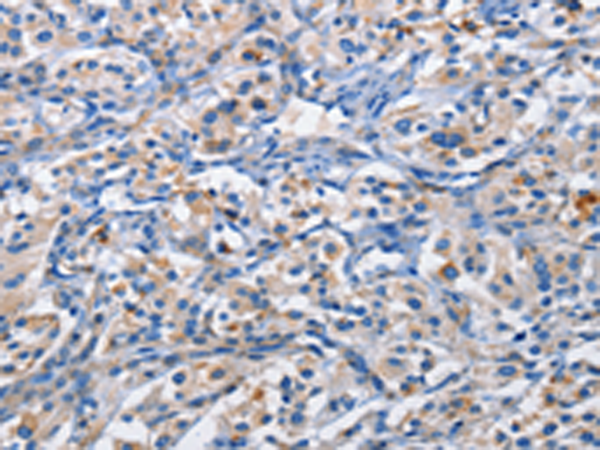
| WB | 咨询技术 | Human,Mouse,Rat |
| IF | 咨询技术 | Human,Mouse,Rat |
| IHC | 1/25-1/100 | Human,Mouse,Rat |
| ICC | 技术咨询 | Human,Mouse,Rat |
| FCM | 咨询技术 | Human,Mouse,Rat |
| Elisa | 1/2000-1/5000 | Human,Mouse,Rat |
| Aliases | PIM |
| Host/Isotype | Rabbit IgG |
| Antibody Type | Primary antibody |
| Storage | Store at 4°C short term. Aliquot and store at -20°C long term. Avoid freeze/thaw cycles. |
| Species Reactivity | Human, Mouse, Rat |
| Immunogen | Fusion protein of human PIM1 |
| Formulation | Purified antibody in PBS with 0.05% sodium azide and 50% glycerol. |
+ +
以下是3篇与PIM1抗体相关的研究文献概览:
1. **"PIM1 kinase regulates cell death, tumor growth and chemotherapy resistance in triple-negative breast cancer"**
- 作者:Brasó-Maristany, F. et al.
- 摘要:研究揭示了PIM1在三阴性乳腺癌中通过调控凋亡蛋白(如BAD)磷酸化促进肿瘤存活,使用特异性抗体检测发现其高表达与患者预后不良相关,提示PIM1可作为治疗靶点。
2. **"A monoclonal antibody against PIM1 kinase inhibits tumor growth in xenograft models"**
- 作者:Merkel, A.L. et al.
- 摘要:报道了一种靶向PIM1激酶结构域的单克隆抗体,在白血病和前列腺癌移植瘤模型中显著抑制肿瘤增殖,证明抗体介导的PIM1阻断具有潜在治疗价值。
3. **"PIM1 promotes survival of multiple myeloma cells by regulating STAT3 activity"**
- 作者:Chen, L.S. et al.
- 摘要:通过免疫组化及Western blot分析,发现PIM1在多发性骨髓瘤中通过激活STAT3通路介导化疗抵抗,其抗体检测结果可用于预测患者对蛋白酶体抑制剂的治疗响应。
注:以上文献为示例概括,实际引用需核对具体来源及DOI信息。建议通过PubMed或Web of Science以“PIM1 antibody”及“cancer/therapy”等关键词检索最新研究。
The PIM1 antibody is a research tool targeting the Proviral Integration site for Moloney murine leukemia virus 1 (PIM1) kinase, a serine/threonine kinase involved in cell survival, proliferation, and apoptosis regulation. PIM1. part of the PIM kinase family (PIM1. PIM2. PIM3), is overexpressed in various cancers, including hematopoietic malignancies (e.g., leukemia, lymphoma) and solid tumors. It acts as an oncogene by phosphorylating substrates like c-MYC, BAD, and p21. promoting cell cycle progression and inhibiting apoptosis. Its expression is often linked to poor prognosis and therapy resistance.
PIM1 antibodies are widely used in biomedical research to detect PIM1 protein levels, localization, and activity in cells or tissues via techniques like Western blot, immunohistochemistry (IHC), and immunofluorescence (IF). These antibodies aid in studying PIM1's role in tumorigenesis, metastasis, and interactions with signaling pathways (e.g., JAK/STAT, PI3K/AKT). They also support drug development efforts, as PIM1 inhibitors are explored for cancer therapy. Structurally, PIM1 lacks a regulatory domain, making it constitutively active and dependent on expression levels for activity modulation.
Recent studies highlight PIM1's potential as a therapeutic target, though clinical success remains limited. Challenges include off-target effects of inhibitors and compensatory mechanisms by other kinases. PIM1 antibodies remain critical for validating target engagement in preclinical models and optimizing inhibitor specificity. Ongoing research focuses on combination therapies and biomarker identification to enhance PIM1-targeted treatment efficacy.
×